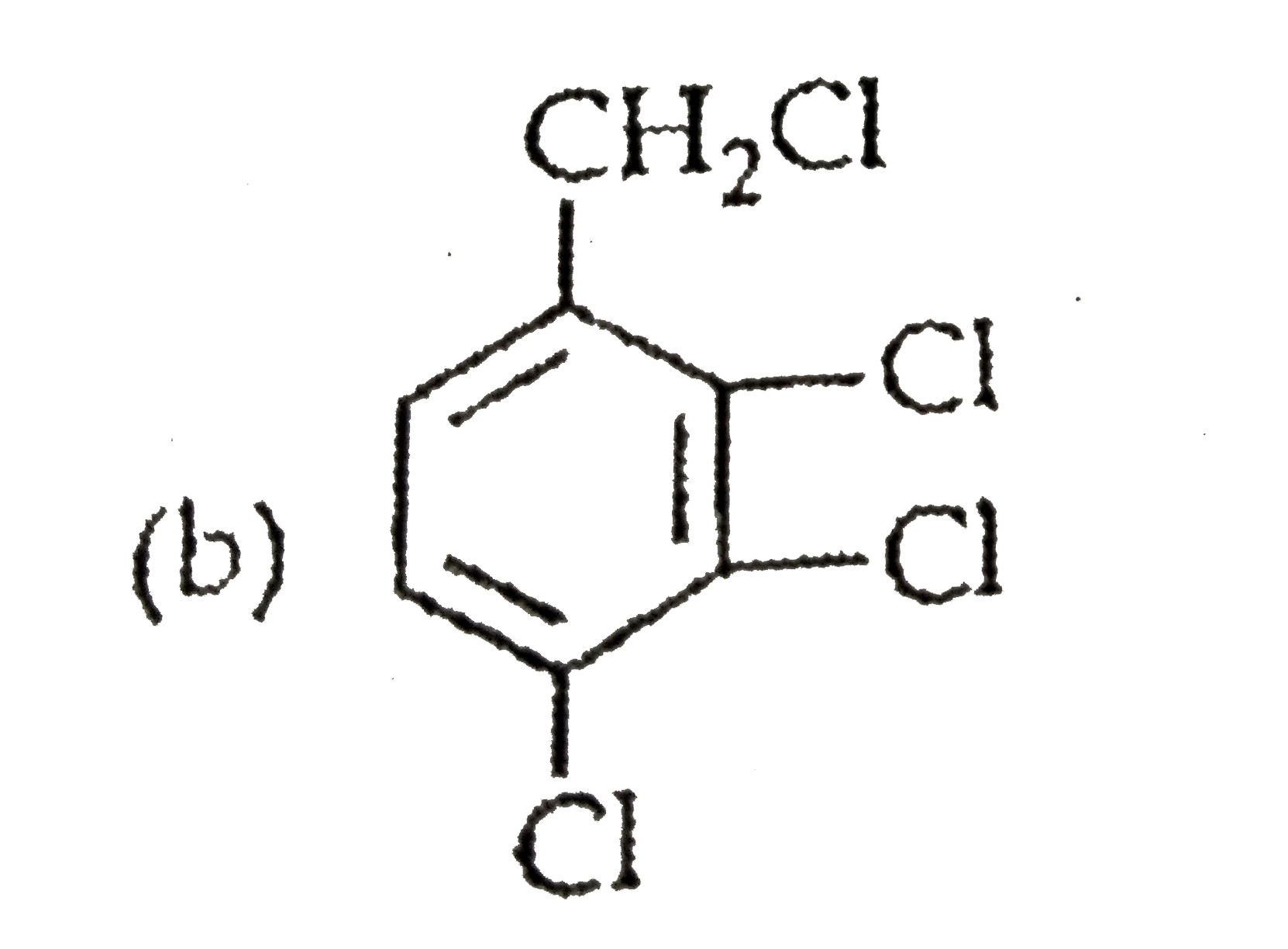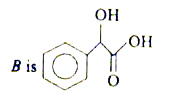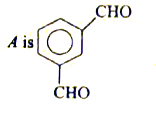An aromatic compound (A), C7,H6Cl2 gives AgCl on boiling with alcoholic AgNO3 soln. And yields C7H7Ocl on treatment with NaOH. (A) on oxidation gives a monochlorobenzoic acid which affords only the monoderivative on nitration the compound (A) is




To solve the problem step by step, we need to analyze the information given in the question about the aromatic compound (A) with the formula C7H6Cl2.
Step 1: Analyze the Molecular Formula
The compound has the molecular formula C7H6Cl2. This suggests that it is an aromatic compound with two chlorine atoms. The presence of two chlorine atoms indicates that it may have a dichloro substitution pattern on a benzene ring.
Hint: Look for a structure that contains a benzene ring with two chlorine substituents.
Step 2: Reaction with Alcoholic AgNO3
The compound (A) gives AgCl upon boiling with alcoholic AgNO3. This indicates that one of the chlorine atoms is likely to be in a benzylic position (attached to a carbon adjacent to the benzene ring). This chlorine can be substituted by the Ag+ ion, leading to the formation of AgCl.
Hint: Consider the position of the chlorine atoms in the compound. One should be benzylic for the reaction to occur.
Step 3: Reaction with NaOH
When treated with NaOH, (A) yields C7H7OCl. This suggests that one of the chlorine atoms is replaced by a hydroxyl group (-OH), forming an alcohol. Since the compound is aromatic, the chlorine at the benzylic position is likely the one that gets replaced.
Hint: Identify which chlorine is likely to be replaced by -OH when treated with NaOH.
Step 4: Oxidation to Monochlorobenzoic Acid
The compound (A) upon oxidation gives a monochlorobenzoic acid. This means that after the oxidation, we still have one chlorine atom remaining on the benzene ring. The oxidation process typically converts the benzylic carbon (where the -CH2Cl was) to a carboxylic acid (-COOH).
Hint: Consider how the oxidation of the benzylic position affects the structure and what remains after oxidation.
Step 5: Nitration of the Monochlorobenzoic Acid
The monochlorobenzoic acid formed from (A) affords only a monoderivative upon nitration. This indicates that the chlorine atom on the benzene ring is likely in a position that allows for only one substitution during nitration, suggesting that it is a meta-directing group.
Hint: Analyze the positions of substituents on the benzene ring to determine how nitration will occur.
Conclusion
Based on the analysis, the structure of compound (A) can be deduced as 2-chlorotoluene (or benzyl chloride with a chlorine at the para position). This structure satisfies all the conditions given in the problem: it reacts with AgNO3 to give AgCl, reacts with NaOH to form an alcohol, oxidizes to give a monochlorobenzoic acid, and yields a single monoderivative upon nitration.
Final Answer: The compound (A) is 1-chloro-4-methylbenzene (p-chlorotoluene).
The compound has the molecular formula C7H6Cl2. This suggests that it is an aromatic compound with two chlorine atoms. The presence of two chlorine atoms indicates that it may have a dichloro substitution pattern on a benzene ring.
The compound (A) gives AgCl upon boiling with alcoholic AgNO3. This indicates that one of the chlorine atoms is likely to be in a benzylic position (attached to a carbon adjacent to the benzene ring). This chlorine can be substituted by the Ag+ ion, leading to the formation of AgCl.
When treated with NaOH, (A) yields C7H7OCl. This suggests that one of the chlorine atoms is replaced by a hydroxyl group (-OH), forming an alcohol. Since the compound is aromatic, the chlorine at the benzylic position is likely the one that gets replaced.
The compound (A) upon oxidation gives a monochlorobenzoic acid. This means that after the oxidation, we still have one chlorine atom remaining on the benzene ring. The oxidation process typically converts the benzylic carbon (where the -CH2Cl was) to a carboxylic acid (-COOH).
The monochlorobenzoic acid formed from (A) affords only a monoderivative upon nitration. This indicates that the chlorine atom on the benzene ring is likely in a position that allows for only one substitution during nitration, suggesting that it is a meta-directing group.
Based on the analysis, the structure of compound (A) can be deduced as 2-chlorotoluene (or benzyl chloride with a chlorine at the para position). This structure satisfies all the conditions given in the problem: it reacts with AgNO3 to give AgCl, reacts with NaOH to form an alcohol, oxidizes to give a monochlorobenzoic acid, and yields a single monoderivative upon nitration.
Similar Questions
An aromatic compound T (C10H10O2) gives 2 moles of CHI2 and compound U (C8H4O4Na) on treatment with I2.and NaOH . After acidification U gives two mononitro products on nitration.
Compound U is
View SolutionAn aromatic compound (A),C8H10, on oxidation with acidic KMnO4 gives dibasic acid. The compound (A) on nitration gives three isomeric nitro derivatives. The compound (A) is:
View Solution
Knowledge Check
Compound (A) C8H6O2 on treatment with aq. NaOH followed by acidification gives (B) C3H2O3 which on oxidation gives benzoic acid only:
A B
B C
C D
D
An organic compound (A), C7H6O gives positive test with Tollen's reagent, on treatment with alcoholic CϴN,(A) yields the compound (B),C14H12O2. Compound (B) on reduction with Zn-Hg, HCl and dehydration gives an unsaturated compound (C), which adds on mole of Br2/CCl4. The compound (B) can oxidized with HNO3 to a compound (D), C14H10O2. Compound (D) on heating with KOH undergoes rearrangement adn subsequent acidification of rearranged products yields an acidic compound (E), C14H12O3.
Compound (A) cannot undergoABenzoin condensationBCannizzaro reactionCAldol condensationDPerkinAn organic compound (A), C7H6O gives positive test with Tollen's reagent, on treatment with alcoholic CϴN,(A) yields the compound (B),C14H12O2. Compound (B) on reduction with Zn-Hg, HCl and dehydration gives an unsaturated compound (C), which adds on mole of Br2/CCl4. The compound (B) can oxidized with HNO3 to a compound (D), C14H10O2. Compound (D) on heating with KOH undergoes rearrangement adn subsequent acidification of rearranged products yields an acidic compound (E), C14H12O3.
Structure of compound (B) isA B
B C
C D
D
The compound which gives H2O2 on treatment with dilute acid is
View SolutionAn organic compound A(C4H9Cl) on the reaction with Na/diethly ether gives a hydrocarbon which on monochlorination gives only one chloro derivative then, A is
View SolutionAn aromatic compound (A), C7H5NO2CI2 on reduction with Sn/HCI gives (G), which on reaction with NaNO2/HCI gives (B). Compound (B) does not form a dye with β-naphthol. However, (B) gives red colour with ceric ammonium nitrate and on oxidation gives an acid (D) of equivalent weight 191. Decarboxylation of (D) gives (E), which forms a mono nitro derivative (F) on nitrotion. Give the structures of (A) to (F) with proper reasoning.
View SolutionCompound (A)(C12H16) on oxidation with acidic KMnO4 solution gives acetone and
 . Identify compound (A).
. Identify compound (A).
View SolutionAn organic compound (A), C7H6O gives positive test with Tollen's reagent, on treatment with alcoholic CϴN,(A) yields the compound (B),C14H12O2. Compound (B) on reduction with Zn-Hg, HCl and dehydration gives an unsaturated compound (C), which adds on mole of Br2/CCl4. The compound (B) can oxidized with HNO3 to a compound (D), C14H10O2. Compound (D) on heating with KOH undergoes rearrangement adn subsequent acidification of rearranged products yields an acidic compound (E), C14H12O3.
Structure of compound (E) is
View Solution
